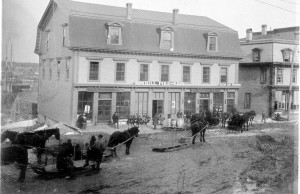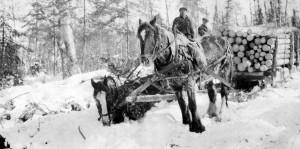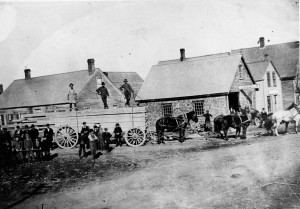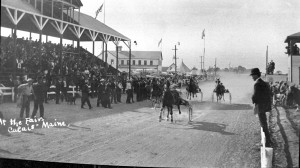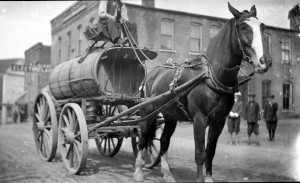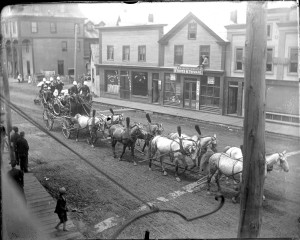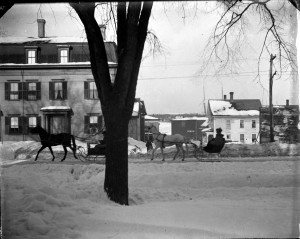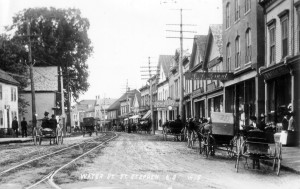The wagon rests in winter, the sleigh in summer, the horse never. -Yiddish Proverb
A good horse cannot be a bad color. -Proverbs
No hour of life is wasted that is spent in the saddle. -Winston Churchill
Nearly all of retail goods sold by stores on Main Street were moved by horse and wagon or sled during winter or mud season from the docks or the outlying farms. The Hill Pike store was on Main Street at the bottom of Church Street and is now the Cole Bridges Garage. The corner of the building to the right is the corner of the Emmans Hotel, then the Border City Hotel and now the location of the gas station which until recently was J.D. Thomas.
Calais was once one of the busiest ports in the United States. Lumber cut into boards, lathes, shingles in the dozens of mills along the St. Croix was the region’s primary export and logging would have been impossible without the horse which in this photo is hauling logs out of the woods.The horse on the left up to his chest in snow. Horses and oxen also dragged trees to the frozen rivers in the winter to be floated to the mills in the spring log drives.
This six horse team is hauling a load of cut lumber from the mills in Milltown Maine to the lumber wharf in Calais, probably the Eaton Long Wharf at the bottom of Calais Avenue. It was a hard pull for the horses, especially the hill on North Street just below what is now Tim Horton’s. In the spring and after heavy rains the hill would be so muddy and rutted as to be nearly impassable and the large loads had a tendency to jackknife. The teamsters who drove these teams were highly skilled and the horses massive powerful animals who were highly prized by the mill owners.
Not all horses were beast of burden, many were breed to race as trotting horses. The area became well known for producing first rate racers.A century ago a good part of population of Calais would have spent Sunday afternoon at the races either at the Calais Trotting Park or across the river at the St Stephen Fairgrounds. Calais had a number of well known horse owners and breeders including Wilfred Eaton, J.M. Johnson, Charles Cone and Charles Kyle and some fairly famous horses were either bred or owned by locals. All the area towns had trotting parks and the best horses traveled the circuit during racing season. It was not uncommon for the steamship Rose Standish to have promotions and special rates for excursions to Eastport on Eastport race days. Brass bands from all over the St Croix Valley accompanied the excursions and held a “Grand Band Tournament” on racing day. This photo can be dated to about 1912 when the new grandstand was built at the Calais ball diamond, then the fairgrounds. It was still standing in the 60’s.
Horses performed many mundane tasks such as pulling the water wagon around the dusty Calais streets. In this photo the wagon is on Monroe Street, the bowling alley, now owned by Nellie Walton can be seen to the right.Then it was Algar’s Electric Laundry. How bad was the dust and when it rained the mud? Here’s the story of the “water wagon” from an article of 100 years ago
“Our good friend would probably notice the roads. There was two or three inches of dust in dry weather, but when it was wet there was at least three inches of mud. One very enterprising storekeeper in the Flatiron Block, had a load of shingle shavings put across so that ladies could cross and not get their skirts so muddy. Once, ladies organized and put a protest to the city government to see if they could not have a sidewalk to the post office so they could keep out of the mud.
Two merchants canvassed the street and they had a big barrel like tank built with a sprinkler at the back. The tank was filled with above the bridge where there was a big high wooden tank of river water which was kept full by a chain of buckets driven by the tide mill. This sprinkler wet the Main street and kept the dust down a little. Clerks, when they had no customers, would take a big feather duster and go out doors and knock some of the dust from the goods, even fruit, on display there.”
There were often as many horses as people in parades. These eight steeds are pulling a band in front of the Flatiron Block which is now Triangle Park. To the right rear is the St Croix Exchange which became the St Croix Hotel. This photo is very early, probably in the 1880’s.
For at least a century in the St Croix Valley most people had a personal relationship with a horse. Large barns were attached to houses to stable the family horse and store the carriages and sleighs which provided transportation to members of the family This 1898 photo shows two sleighs passing in front of the Holmestead in Calais 1898. Across the street is the building many of us knew as the Charles hotel.
With the coming of spring the sleigh was retired and Old Dobbin was hitched to the family carriage. There were bewildering number of types of carriages just as there are dozens of models of cars today. Some are on view in this photo of Water Street in St Stephen about 1900.
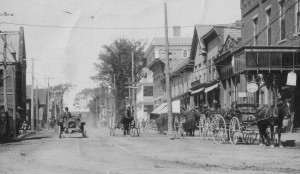
The intersection of transportation can be seen here in St. Stephen: horse and buggies and an early car are each visible.

